Over the last few decades, we've learned a lot of interesting things about the Universe. One of the most groundbreaking is that most of the matter in the Universe is not made up of all the stuff we know as normal matter: protons, neutrons, and electrons.
This means that atoms, the basic building block of all we know and love on Earth, make up only a small fraction of the mass in the Universe.
How do we know this? Well, there are lots of reasons, but they all boil down to these two things: we use telescopes to measure light, which tells us about the amount of normal matter in the Universe, and we also observe the motion of matter to measure gravity, which tells us about the total amount of matter in the Universe.
If these two numbers were the same, the observations would tell us so. But there's a nail-in-the-coffin of not having dark matter, and here's the image that proves it:
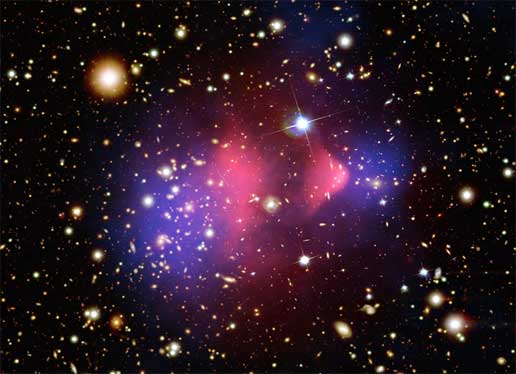
Here are two clusters of galaxies that have just collided. The pink is where X-rays are emitted, which means this is where normal atoms are colliding, heating up, and emitting light. This is what normal matter does, and we see plenty of it.
But mass also bends light, and so we can -- just from looking at all the light coming from behind these clusters -- figure out how much total mass there is, and where it is. And it's in blue, which tells us two things. First off, there's a type of matter, that's where most of the mass is, that isn't made up of atoms! That's what dark matter is, and there are plenty of other colliding galaxy clusters that show this.
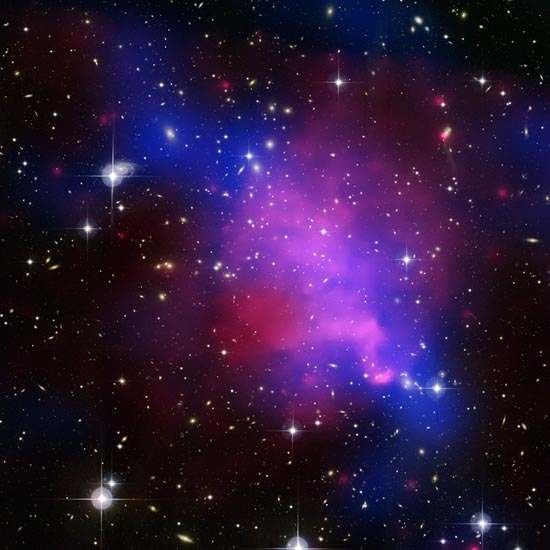
For instance, there's cluster Abell 520, above, and cluster MACS J0025, below.

But there's a second thing that we can learn from these images, which is that -- unlike normal matter -- dark matter doesn't go SPLAT! when it collides!
Instead, dark matter just passes right through itself, passes right through normal matter, and only through its gravity does anything influence it at all.
So that's what we know about dark matter, and that's (partially) how we know it.
Now, we also know that whatever dark matter actually is, there's a lot of it. And -- what's more -- dark matter is probably its own anti-particle. Under normal circumstances, when you collide matter and anti-matter together, you get pure energy out, and an equal amount of matter and anti-matter. We see this all the time around black holes, which are anti-matter factories.
And, not surprisingly, we see this at the center of our galaxy, too. Take a look:
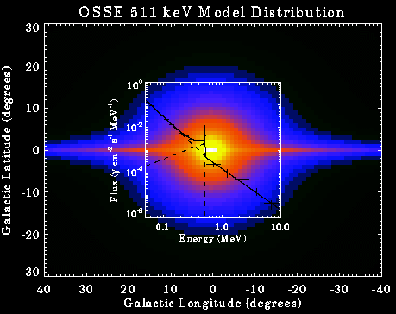
I say not surprisingly, because we know there's a supermassive black hole at the galactic center! But what is surprising is that a whole bunch of scientists are blaming dark matter for this excess of energy instead of blaming the black hole!
Here's the kicker, though. This extra energy could, in principle, be caused by either one. There's a test we can do. If it's caused by a black hole, we would see extra positrons, but not extra anti-protons. If it's caused by dark matter, we would see excesses of both. Let's go to the data. First, this experiment that's been getting a lot of press, PAMELA, measured the positrons very accurately.

And they found them! But when they looked for extra anti-protons, here's what they found:
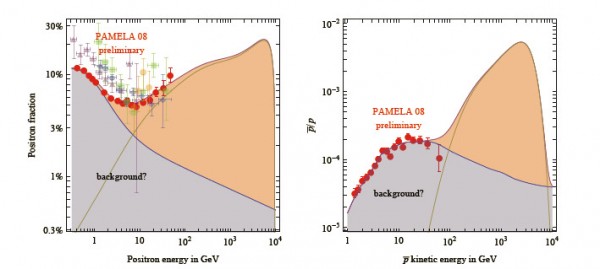
Absolutely nothing! Now, PAMELA doesn't have the sensitivity to measure this definitively, but I don't know why everyone's all excited, calling this dark matter, since the evidence isn't there! If anything, this tells us that it's more likely that there's something interesting going on with black holes, causing them to spit out positrons!
So, yes, it's possible that these positrons are coming from dark matter, and that evidence of anti-protons would support that. But with the evidence we have, that's not even the most likely explanation for them! The sensationalism is painful to be surrounded by, and even though I have a special affinity for dark matter, this smells more like a black hole to me.


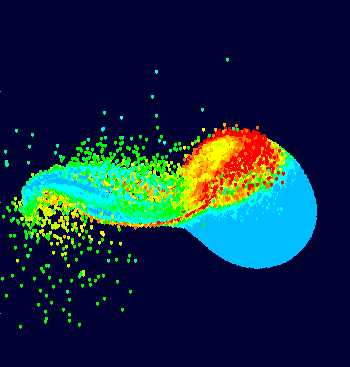
Why would you see more extra positrons from the black hole but not anti-protons?
Tony,
Thanks for your question! If you want to make something from nothing (like around a black hole), it depends on how much energy you have. Making things of higher energies are exponentially supressed as you go up in energy, and protons (and anti-protons) are about 2,000 times more massive than electrons. Hence, their production is suppressed.
However, if you want to make something from annihilating dark matter, you can make it so long as the mass of what you're making is less than the mass of dark matter particles. Since dark matter is ~ 100-200 times more massive than protons, it doesn't care whether it makes proton/anti-proton pairs or electron/positron pairs; it's got enough energy to easily do either.
And that's why there's a difference.
Ethan, Welcome to the Borg! Great graphics, by the way...
Hey, if it doesn't go "splat" can you really call it matter???? I mean, if Pluto is not a planet, then this stuff might not really be matter. Maybe matteroid or something....
"...dark matter doesn't go SPLAT! when it collides! Splat in a collision Instead, dark matter just passes right through itself, passes right through normal matter, and only through its gravity does anything influence it at all."
How had I never heard about this? That is incredible. Reality sure is weird.
Great post. I'm one of those biologists with a physics envy.
I've always believed that dark matter may be some kind of hyper-dimensional object... like a 5 or 6 dimensional object, and what we observe and understand of dark matter is merely just the part of the object that interacts with our 4-d space. I haven't heard anything about it in from the scientific community - and I try to keep abreast, as theoretical physics is an area this otherwise "normal" MS English Teacher really enjoys (the theories, anyway - not so good with the math part, though) :)
Hmmm, true, but isn't there a problem with the black hole explanation in that electrons/positrons of that energy are only expected to travel less than a kpc or so before multiple scatterings take them well below energies of order 1 GeV?
My impression was that while a black hole could, in principle, explain it, it would have to be an awfully close one. Of course, the astrophysics part of things is very much not my area of expertise (still working on getting good with quantum field theories). What I've read is that it's pulsars and supernova remnants that are the big candidates for astrophysical sources (from what I've read so far, anyway).
As far as dark matter goes, getting around the lack of an antiproton excess is easy (model builders are clever and, with the LHC under repair, very bored), the thing that's ruling out different pet models is avoiding an unseen excess of high energy photons, as the talk I was at earlier today focused on.
I think all of that is reasonably coherent, my head is a bit swimmy at the moment, TAing early on Mondays always zonks me out.
Congrats on being assimilated, by the way, I came over from a link from PZ, and I'm definitely adding you to the reader.
Just wanted to say, "Cool site." I'm sure I'll be spending some time here. Thanks. Liked the egg thing particularly. Interesting, and...idea for dinner now.
"But there's a second thing that we can learn from these images, which is that -- unlike normal matter -- dark matter doesn't go SPLAT! when it collides! Instead, dark matter just passes right through itself, passes right through normal matter, and only through its gravity does anything influence it at all."
1st off, let me say great site. I especially like the pic (makes me wonder if you were on Gladiators, or if it's a costume for some freaky-geeky party) ;)
The question I have regarding the quote is: What would we expect an interaction between dark matter to look like at the distances about which we're talking, and why do we think we know what any interaction between dark matter would look like at all, when we know so little about it?
I've read and understand your response to Tony (regarding the supposed mass of dark matter being greater than either protons or electrons or their anti-s, and so yielding both...I'm also wondering why we think we know the mass of a particle of dark matter...but feel free to limit your answers to what's outside the parintheses), but I wonder if evidence of positrons/anti-protons would be apparent from the distance of colliding galaxies? Put another way, is there a spectrographic fingerprint that points to protons/electrons that we should assume would come from dark matter, if dark matter were to interact? Or, is it that there isn't enough interactions in the x-ray that we assume/deduce dark matter to be non-reactive (I may have just answered my own question...but will still post it)?
In other words (and being a little facetious with my negatives), if all we can see isn't dark matter, then how do we know what we're not looking at?
Welcome to the boards ;)
josh
Hi Ethan- willkommen!
I've spoken with theorists who disputed the idea that dark matter exists at all. Specifically, they feel that the simplest explanation for the observed data is simply that our current understanding of gravity is all wrong.
That's fairly compelling, if only because we do know pretty darned little about gravity.
Still, in the last several years, I've seen more and more "announcements" of evidence of dark matter. Not once have I seen any such announcement discuss the possibility that other theories of gravity might explain the data (clearly it's a non-popular, possibly crackpottish, viewpoint!).
So I'll directly ask --- is it still possible that a new theory of gravity may explain the data that otherwise seems to indicate the presence of dark matter?
"Over the last few decades, we've learned a lot of interesting things about the Universe. One of the most groundbreaking is that most of the matter in the Universe is not made up of all the stuff we know as normal matter: protons, neutrons, and electrons.
This means that atoms, the basic building block of all we know and love on Earth, make up only a small fraction of the mass in the Universe.
What about Plasma?
"Students using astrophysical textbooks remain essentially ignorant of even the existence of plasma concepts, despite the fact that some of them have been known for half a century. The conclusion is that astrophysics is too important to be left in the hands of astrophysicists who have gotten their main knowledge from these textbooks. Earthbound and space telescope data must be treated by scientists who are familiar with laboratory and magnetospheric physics and circuit theory, and of course with modern plasma theory."
-- Hannes Alfven
gotta love the plasma people!
via pharyngula: yay! astrophysics!
I don't really understand anti-matter, but this was still an interesting post. I'm happy you've come to scienceblogs.
Oh, and I just have to say it: when I first glanced at the picture of (presumably) you, I swear to god, I thought it was Richards Simmons! LOL
Hi Ethan, I've read about theoretical Islands of Stability. Groupings of very heavy elements that may remain stable. I'm wondering what a black hole might be made of. That is, could it even be considered an element? Black Hole 1143?
Hi Ethan, popping over from Pharyngula. I've been following your blog for some time. Nice to see you've been assimilated into the hive. I like following both the biological and the astrophysical. Welcome!
Wow, so many comments to respond to!
So let's see.
Plasma: We detect plasma also, and group that in with normal matter. It's still protons, neutrons, and electrons, just at higher temperatures. And Alfven is right, Plasma Physics is hard and most physicists don't learn it!
Theoretical islands of stability: These don't seem to be well-motivated. It seems that the higher up the periodic table we get, these nuclei simply won't stay together. An atomic nucleus is kind of like an amoeba: you get too big, and you're just going to divide.
Nuclear abundances: Yes, the radioactive decay time of Pu-244 is 83 million years, which is significantly shorter than U-235's of 630 million years. But the abundance of Pu is, AFAIK, zero, and that claimed detections of it occurring naturally have failed to be confirmed. This means that far less Pu was produced in the supernova that created us than Uranium.
But the decay time is important, too. There should be much, much more Plutonium around when a planet is only 1 billion years old than when it's 4.5 billion.
Dark matter: It definitely exists. You can not modify gravity to account for the observations of colliding galaxy clusters. Not even with a crazy model, unless you want a separate model of gravity for every colliding galaxy cluster pair. Perhaps I should explain this in a post sometime.
The mass of dark matter: This is not known. But there are a few classes of theories: not a particle, super light, intermediate mass, heavy, and super heavy. The first two can't make an electron/positron excess, so they're out. Intermediate mass would make an electron/positron excess, but there would be other signatures (in the Sun, for instance) that we would see. We don't see them, so they're out. The other two, heavy and super-heavy, can decay into proton/anti-protons as well as electrons/positrons. That's why we need to see the proton/antiprotons before this is even news.
No splat? Yes, dark matter has no splat. If you sent a ball of it through the Earth, you would get a ball of it on the other side about 88 minutes later.
If it's "dark", then doesn't it even emit light based on its temperature?
Wouldn't a particle acting as its own anti-particle be a contradiction of what is currently established? (Unless perhaps it fell apart and could produce particle 'x' or its antiparticle.)
Can neutrons exist in isolation, and if they could, what properties would be expected of them? Well, they wouldn't just go through the earth, but how did people come to the conclusion that 'dark matter' will pass through itself and through matter?
We're all waiting for 50 years of physics to be explained in a nice short post. :)
Hi Ethan
I'm just starting into physics formally after years of reading lay physics books. Anyway, I have a few questions if you don't mind.
First of all, nuclear abundances. Do we use the abundances of elements that we see in our solar system to calculate the energy released at the super nova that made it? Does this give us information about the star itself and can we use similar information about other stars to get a picture of the evolution of the galaxy?
Dark matter: can it be considered a massive integer spin particle (or class of particles) that simply has no strong interaction? Do we have information on weak or electromagnetic interaction? Is a lack of electromagnetic interaction what makes it dark (or transparent)?
sorry I have more questions but have recently switched to Dvorak. 'nuf said. :P
Thanks for your note re: gravity. I for one would be very interested to hear what you have to say on the topic.
It's a petty comment, but this is the first time I've learned that the name of this experiment is PAMELA, and have gotten proud little jolt to know that I share my first name with a grand physics experiment like this.
As far as I understand, this still happens because you are accelerating (thermal motion) charged particles (to understand it from a classical viewpoint). Dark matter just simply appears to have zero coupling to the photon.
No, what we know now is that special relativity implies that every particle should have an associated antiparticle, but there is no requirement that they be distinct. For example, light (photons) is its own antiparticle. We also know of the neutral pion which is its own antiparticle as well. The unique thing about these dark matter particles in the form postulated now would be that they would have this property and be fermions - which is something that seems to be allowed by the laws of physics but not realized anywhere in nature (BUT neutrinos may still be their own antiparticle too, the jury is still out on that - in that case we would already know of one like that!)
They sure can. People do experiments with free neutrons all the time, but they are readily drawn into the nucleus of certain atoms (neutron absorption), and they also have a very short lifetime, since they are unstable outside of the nucleus. Off the top of my head I think the mean lifetime of a free neutron is something like 12 minutes, which kind of excludes them from being responsible for large scale structures (except for exotic conditions like neutron stars).
Note also that neutrons do couple to light! Despite being electrically neutral overall, the neutron is composed of objects that do have electric charge, and as a consequence it couples to magnetic fields and can thus radiate light!
Structures made of normal matter repel eachother because while atoms are overall neutral, when you bring two atoms close to eachother the electron clouds of each one begins to "see" the other, and they push eachother away. What's keeping you from falling through your seat right now are the electrons on the surface of your body repelling the electrons on the surface of the seat. They do this through elecromagnetic interactions, but dark matter does not interact electromagnetically at all! Therefore what we call solid simply has no meaning for dark matter, or even any neutral fundamental particle. Neutrinos, for example, are passing through you at a tremendous rate and they don't even notice your atoms, save for the rare occasion that they interact via the weak force with you. (very very very rare - as in I wouldn't be surprised if it never happened in your lifetime rare)
I hope I've been able to clear things up a bit while we wait for more replies from our gracious blogger/host.
Thank god I´m made of bright matter.
Clarification on wording: I meant that thermal emission of light still relies on there being electrically charged particles involved, so, since the hypothetical dark matter particles would have no coupling to E&M at all, (i.e. no charge, no magnetic moment etc) they still would not radiate thermally.
Ethan, will of course, have good observational evidence that DM doesn't thermally radiate. I myself am a particle physics guy, so I have little/no expertise in what the current observational evidence is. My guess would be no better than your googling ;)
Because there has been so much hubbub over here, I've got a follow-up post that I hope clears some things up:
http://scienceblogs.com/startswithabang/2009/04/colliding_dark_matter.p…
DM, for those of you interested, have *no* electromagnetic interactions as far as we've been able to measure. No radiating, no absorbing, no colliding, no nothing. And we'll keep on looking!
FYI: Dark matter has no strong, no EM, and if it does have weak, it's much weaker than neutrinos (!) in terms of its interactions.
People are hoping for some very, very, very faint either EM (through -- for the particle physics-savvy -- higher loop diagrams) or weak interactions in searching for it, but so far, no luck in finding anything.
A ball of dark matter would interact with the earth as it goes through. Its gravitational force would provide some disturbance (tidal force) as it passed through. If this weren't true we wouldn't have needed to postulate dark matters existence to understand rotation of galaxies.
Bobh,
You are assuming that dark matter makes clumps of appreciable density (we think they do not) and that this would have a measurable effect on the Earth (we think it does not) as they pass through it.
But, we *do* believe that dark matter passes through the Earth, and that's exactly what we've built experiments to search for. Just... all negative (or one unconfirmed positive) so far.
You used the term "ball of dark matter" I was not assuming anything about its density. In the experiments you are referring to are you expecting any interaction other than gravitational? By definition you would need a "measurable effect". That was what I was assuming in my comment about 'tidal', that one might be able to measure a differential effect.
We are a group that is challenging the current paradigm in physics which is Quantum Mechanics and String Theory. There is a new Theory of Everything Breakthrough. It exposes the flaws in both Quantum Theory and String Theory. Please Help us set the physics community back on the right course and prove that Einstein was right! Visit our site The Theory of
Super Relativity: Super Relativity
Hi Ethan,
A couple of questions.
1) So dark matter can't be made to radiate in any way? What if it gets hot? Is it even meaningful to discuss "heat" in the context of non-smoosh matter? If not, then how do you talk about themodynamics? But if yes, then wouldn't hot dark matter have to radiate... something?
2) If DM doesn't smoosh, then why hasn't it collapsed into black holes? I mean -- ordinary interstellar matter, which is mostly hydrogen gas with some helium and dust and "metals" collapses under its own gravity to form stars. But dark matter would just keep collapsing inward, right? There's no EM "brake". So why isn't it all disappearing into black holes?
3) Wouldn't large masses, like stars, sweep up some DM in their dense cores? Is there any evidence of this?
4) Finally, a science-fictional conceit: if you could manipulate dark matter, couldn't you use it in (for instance) terraforming? Mars isn't massive enough, so dump half a Mars mass of DM into its core? The DM just hangs around in there, ignoring the normal matter, but now Mars is more massive... right?
Okay, that was more than a couple, sorry.. Thanks for the great post!
Doug M.
Hi Ethan,
I would be interested in your comments on the following. One is, that in my view, currently science is not working as well as it might. We are becoming extraordinarily skillful at measuring things and acquiring data, but the acquisition of this data comes at the price that nobody can possibly keep up with it all, and we do not have the time nor the place to analyze it properly. If a theory does not "ignite" it simply gets lost. Even if it is not "right", or seen to be correct at the time, or if it is not readily comprehended, it simply gets lost in the morass. At this stage I should add the caveat to readers that I have proposed theories that are generally ignored, and as such, I have sympathy for others in the same position.
Dark matter provides a classic example, which, fortunately, involves none of my work. The German Burkhard Heim produced a theory, which I admit I do not understand, but nevertheless he predicted the existence of a neutral electron, approximately 1% heavier than an ordinary electron and of infinite lifetime. (He also predicted some heavy neutrinos.) Now, if we assume such a particle would be its own antiparticle, it seems to me it meets the criteria for dark matter rather well. Because it is a fermion, due to the Exclusion Principle, it cannot "clump", because it has no charge it presumably does not interact with the electromagnetic fields, because it is a lepton it presumably does not interact with the strong force, and it is rather difficult to see how it could interact through the weak force. Now, if we assume that all matter condensed from some initial "big bang", and that matter mainly cancelled out antimatter but for a small asymmetry, then if these were made in roughly the same numbers, there would now be enormously more of them. Their mass is low, but their numbers would easily make up for that. (Because quarks must have fractional charge, there are no hadron equivalents.)
So, as far as I can see, this proposed particle at least meets most of the criteria of dark matter, but as far as I can make out, it is never considered. My guess is, most physicists haven't heard of it, although there may be a perfectly good reason of which I am unaware, which gets me to the main reason for this posting. I do not believe the current means of scientific publication is necessarily sufficient to deal with a number of our current issues. I know there would be management issues, but I feel a lot of issues like this could be better discussed if there were somewhere, such as on the web, where proper moderated logic analyses could be carried out on scientific issues where there is a perceived problem. Nobody can be expected to know everything, but by having everybody able to contribute their point, and what they know that others might not, more progress might be possible. (I know there would be a lot of work for someone moderating potential chaos, but....)
Ian Miller
Small problem with Mars. It doesn't produce a large enough magnetic field to divert the solar wind. You could smash dark matter and cometary water into it, but eventually, it would become uninhabitable again.
BTW, has anyone seen the trailer for "Sunshine"? Oy. Deus ex machina....
http://www.youtube.com/watch?v=YZ2-xR54UDU
The below text are free translations of PLATO, PLOTIN, PYTHAGOREANS & SEXTUS EMPIRICUS -There is a book of PLATON about QVANTO MEKANICS Try to find it in your language in a good translation.
I will try to remind you some things that have been said by these people 1800 to 2700 years ago. At first there is no dark black red yellow or white matter or any matter at all. That is because there is no size -big or small- in universe -there is no big or small at all. All are combinations of what we call IDEAS and KNOWLEDGE. There is no time because time is the mesure of movement in space So there is only movement and nothing lost or new been created because you can not take something out of universe -space- and you can not put something in it because all already exist and all are creations of the already existing KNOWLEDGE which is an IDEA of being and recreating the same IDEA. Space can not expand because where to expand to? that is because space has no size and as we understand there is no limit or size -end or begin- you need more space or space can not be smaler because what will left what. We see in a way with our senses -and our senses can not see all- and that is not the truth because any truth needs prof and every prof needs prof and so on. Everything after you see it if you see it again it will be different and next time also. So any prof must be again remake and again and again. Dark blue red are only names that we give and universe has nothing to do with that. If universe listens what you -or I-said it will hear vsiuv984v 3984ve98vv 98vs9h or whatever because you said nothing to it and it cares not about whatever we said -it cares only if this is conects with it in harmony based on it's contstant changing. Also the whole thing about universe is that we take logic from it and soul and whatever we think so that means that whatever we thing is already made by universe. If the harmonics in our thoughts do not in-harmonize with it it will be conflict. But even when we not harmonize with it it is natural and there is a logic beyond that. Questions: Have we seen an electron? a proton? How these look like? The pictures of the galaxies are mostly funny -are just spots that I can make them on a paper. Do we know why a color is the way we see it and why this color exists? It is possible that the color don't exist but we see it as color and may be it is something very different than color. Anyway I stop here. And sorry for my english writing which is not so good but I think that you understand what I am trying to say. Regards -Stefan Glaufx.
Small problem with Mars. It doesn't produce a large enough magnetic field to divert the solar wind. You could smash dark matter and cometary water into it, but eventually, it would become uninhabitable again.
I am so in agreement that 'new' discoveries blitz us and are never tied together so get lost. I am forever recalling a science new brief that would support/confront another science report I am reading but can't find it. This makes no sense.
When the compression of our heliosphere ends 2013 will we be any better positioned to offer a comprehensive theory or are we stuck in the power position of having to OWN some new tech that would allow us to stay king of the hill. What a waste.